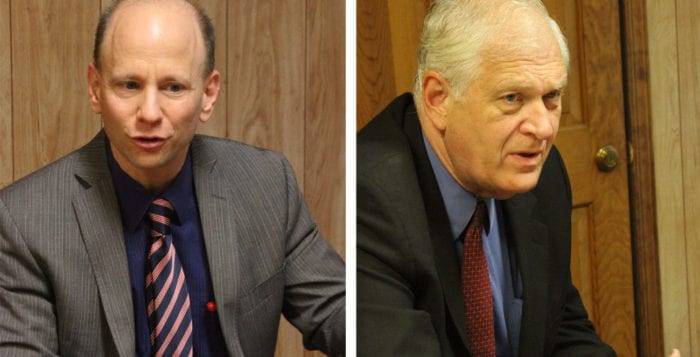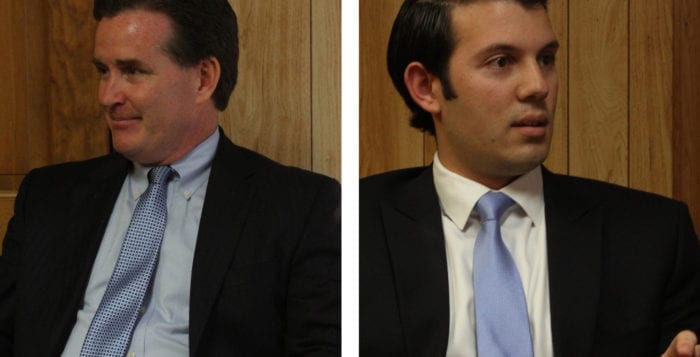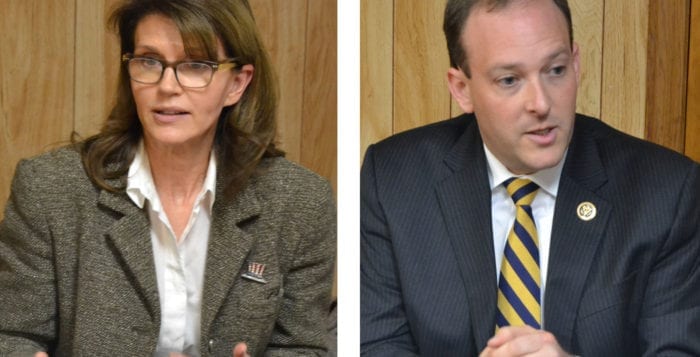Ken LaValle (R-Port Jefferson) has been a New York State senator for nearly four decades, and although he’s joked about retirement, he doesn’t plan on vacating the position just yet. That won’t stop Democratic challenger Greg Fischer from trying to unseat him Nov. 8.
According to a 2015 New York Public Interest Research Group Report, LaValle was ranked second of 63 legislators in words said on the Senate floor, second in bill introduction, fourth in those that passed the senate and second in those that passed both houses.
“It’s a record of relevancy that I think is pretty good,” LaValle said in an interview at TBR News Media’s main office when the combatants sat down to discuss their campaigns.
LaValle said he’s excited for the chance to amend the East End’s Community Preservation Fund, which is responsible for the preservation of more than 3,000 acres of vacant land on Eastern Long Island and also improves parcels of historic, recreational and environmental value. He also noted the $400 million in construction going on at Stony Brook University Hospital that will produce jobs for doctors, clerks and others.
Fischer is a business consultant who has a passion for economics, he said, and he sees the economy as the “most important issue of our day, especially for the district.”
“We’re constantly on this treadmill of tax and spend, tax and spend,” he said. “And even though I’m a Democrat and you hear Democrats labeled for that, my background is in business and my background is to find the best value.”
The candidates are in support of the two percent tax levy increase cap for property owners as a means to curb government overspending, though Fischer said he isn’t sure the policy goes far enough. “It’s only applying the brakes gently — it’s not fixing the problem,” he said.
Fischer is running on the mantra: “It’s time for a turnaround.” His platform is about reform, which he said would be a product of his background. He’s not a lawyer like many other legislators.
Fischer said he thinks new blood and a democratic representative are needed to be able to better address not just the district’s issues, but statewide issues.
“There’s so much we can do, but we’re moving so slowly,” he said. “I think that’s the danger. We all know where we’re headed. People want to move out of state. Students want to be accepted out of state so they can stay out of state.”
To combat that mentality, LaValle said he’s been conducting research on millennials, regarding whether or not they want to be homebuyers or renters, or drive a car as their primary means of transportation. LaValle co-sponsored legislation to allow municipalities to continue tax exceptions for first-time homebuyers of newly constructed homes as an incentive. He is also a supporter of New York State’s School Tax Relief Program, which lowers property taxes for owner-occupied primary residences. As chairman of the Higher Education Committee, LaValle said he’s also trying to address how to minimize millennial debt.
Fischer said he’s a proponent of free tuition for Suffolk County and New York State residents.
Fisher has run unsuccessful campaigns for Riverhead Town and local school board offices. He previously sued the Long Island Power Authority and conducted his own audits of Riverhead school district. More recently, he filed a lawsuit claiming Stony Brook University named its football stadium for LaValle after he secured $22 million in state funds for the venue’s construction, stating in his notice of claim that “It is ludicrous for sitting legislators (seeking re-election or otherwise) to have public structures named for them for the de facto benefit of their personal political careers.” Fischer asked LaValle’s name be removed from both the Nov. 8 ballot and the stadium. The arena was opened and named after LaValle in 2002.
Fischer said another issue he’d like to address is corruption in the courtroom, and added he’d like to see cameras allowed in state courtrooms.
“I think there needs to be more scrutiny of the judicial process,” he said. “We have a huge problem with corruption. There have been a lot of problems where the transcripts are changed after the fact, and things happen that are problematic.”
Fischer also said he believes legislation takes too long in New York, and cited response to the growing opioid abuse issue as an example. While LaValle said it’s his No. 1 priority — adding that many of his colleagues say the same — he believes increased penalties for dealers could put a dent in that problem.
Fischer said he understands enforcement sells, but added it’s only part of the solution.
“Of course we have to do some more enforcement, but it’s a mental health issue,” he said. “We have reasons for people doing these drugs — even in the suburbs — it’s despair. By the time you’re detecting use, you’ve already got a real problem going on. We have to have a whole new way of thinking about deterrence and really scaring children into the reality that, as a first use, you could have a dependency for life.”






























